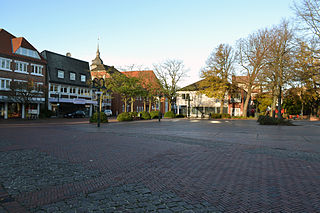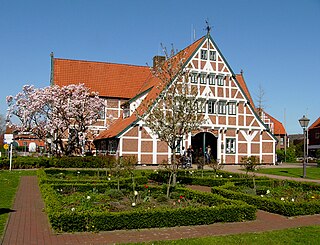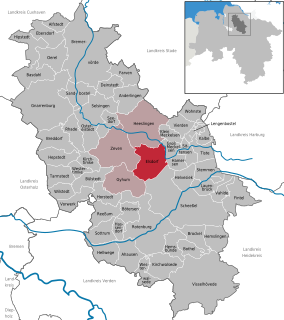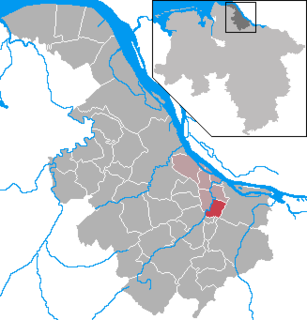This article needs additional citations for verification .(April 2015) (Learn how and when to remove this template message) |
| Selsingen | ||
|---|---|---|
| ||
| Coordinates: 53°22′N09°13′E / 53.367°N 9.217°E Coordinates: 53°22′N09°13′E / 53.367°N 9.217°E | ||
| Country | Germany | |
| State | Lower Saxony | |
| District | Rotenburg (Wümme) | |
| Municipal assoc. | Selsingen | |
| Government | ||
| • Mayor | Reinhard Aufdemkamp (CDU) | |
| Area | ||
| • Total | 41.86 km2 (16.16 sq mi) | |
| Elevation | 27 m (89 ft) | |
| Population (2015-12-31) [1] | ||
| • Total | 3,647 | |
| • Density | 87/km2 (230/sq mi) | |
| Time zone | CET/CEST (UTC+1/+2) | |
| Postal codes | 27446 | |
| Dialling codes | 04284 | |
| Vehicle registration | ROW | |
Selsingen is a municipality in the district of Rotenburg, in Lower Saxony, Germany. It is situated approximately 15 kilometres (9.3 mi) southeast of Bremervörde, and 45 kilometres (28 mi) northeast of Bremen, and is twinned with the English village of Sawston in Cambridgeshire.

Rotenburg is a district (Landkreis) in Lower Saxony, Germany. It is landlocked by the districts of Stade, Harburg, Heidekreis, Verden, Osterholz and Cuxhaven.

Lower Saxony is a German state (Land) situated in northwestern Germany. It is the second-largest state by land area, with 47,624 km2 (18,388 sq mi), and fourth-largest in population among the 16 Länder federated as the Federal Republic of Germany. In rural areas, Northern Low Saxon and Saterland Frisian are still spoken, but the number of speakers is declining.

Germany, officially the Federal Republic of Germany, is a country in Central and Western Europe, lying between the Baltic and North Seas to the north, and the Alps to the south. It borders Denmark to the north, Poland and the Czech Republic to the east, Austria and Switzerland to the south, France to the southwest, and Luxembourg, Belgium and the Netherlands to the west.
Selsingen belonged - as to its government - to the Prince-Archbishopric of Bremen, established in 1180. [2] In religious respect, however, Selsingen formed part of the Roman Catholic Diocese of Verden until after 1566 its incumbent bishops lost papal recognition, except of a last Catholic bishop from 1630 to 1631, respectively. [2] In 1648 the Prince-Archbishopric was transformed into the Duchy of Bremen, which was first ruled in personal union by the Swedish and from 1715 on by the Hanoverian Crown. In 1823 the Duchy was abolished and its territory became part of the Stade Region.
A personal union is the combination of two or more states that have the same monarch while their boundaries, laws, and interests remain distinct. A real union, by contrast, would involve the constituent states being to some extent interlinked, such as by sharing some limited governmental institutions. In a federation and a unitary state, a central (federal) government spanning all member states exists, with the degree of self-governance distinguishing the two. The ruler in a personal union does not need to be a hereditary monarch.
The Stade Region emerged in 1823 by an administrative reorganisation of the dominions of the Kingdom of Hanover, a sovereign state, whose then territory is almost completely part of today's German federal state of Lower Saxony. Until 1837 the Kingdom of Hanover was ruled in personal union by the Kings of the United Kingdom of Great Britain and Ireland.
Selsingen is also the seat of the Samtgemeinde ("collective municipality") Selsingen.
A Samtgemeinde is an administrative division in Lower Saxony, Germany. It is equivalent with the Amt, and the Verbandsgemeinde (Rhineland-Palatinate). It is an association of municipalities, which executes administrative duties for its member municipalities. A Samtgemeinde should have at least 7,000 inhabitants. The tasks of the Samtgemeinden may be land use planning, wastewater disposal, social security or the organisation of cemeteries and fire stations. It also takes over the sponsorship of elementary schools, the construction of local connecting roads, equipment and entertainment of libraries, sports sites and establishment of other public equipment and can take over other tasks of the member municipalities, for instance, tourism. A large part of the municipalities of Lower Saxony has united to Samtgemeinden.
Selsingen is a Samtgemeinde in the district of Rotenburg, in Lower Saxony, Germany. Its seat is in the village Selsingen.



















